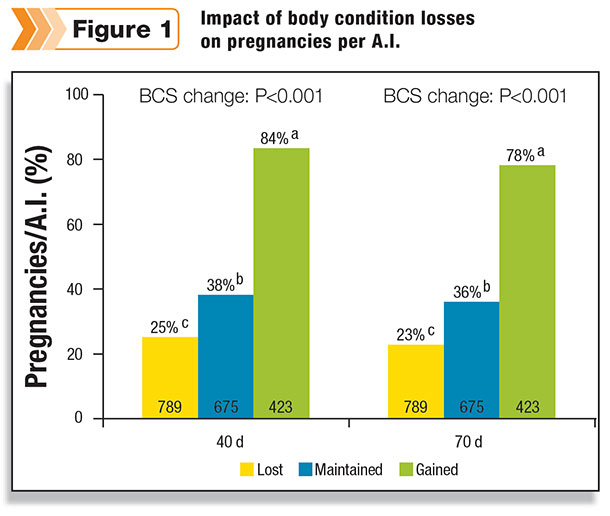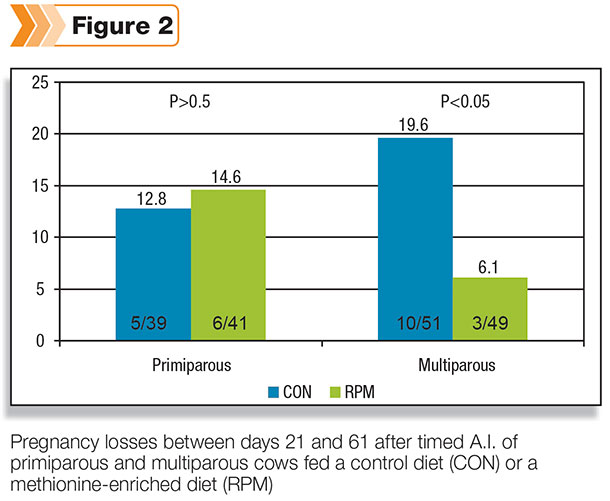Decreasing reproductive efficiency in dairy cattle has been documented not only in the U.S. but also in Ireland, the United Kingdom and Australia. Ideally, cows should be pregnant by 85 days in milk, the conception rate at first breeding should be more than 50 percent, the numbers of breeding per lactation should be less than 1.7, and the calving interval should be less than 390 days.
Such goals are hard to reach, and progress is slow. Between 1996 and 2007, the days to first breeding of the U.S. Holstein herd were improved from 92 to 85 days, a trend in the right direction. However, the number of inseminations per lactation and calving interval increased from 2.1 to 2.5 and from 410 to 422 days, respectively.
Pregnancy rate (PR) depends on both heat detection (HD) and conception rate. Improving HD would improve the PR. Over the last several years, many insemination protocols have been designed to better synchronize heat, thus improving the odds of success to improve the PR.
However, less than 50 percent of cows become pregnant at first insemination; therefore, cows need to be inseminated at least twice. Despite the availability of many successful HD and synchronizing protocols, an essential goal must still be to create a healthy uterine environment to ensure the embryo reaches term. Success or failure depends on what happens during the transition period.
Transition is critical for reproduction
A recent study evaluated the effect of body condition score (BCS) near timed A.I. (TAI) on reproductive performance of lactating dairy cows. The pregnancies per A.I. were greater for cows that gained BCS, intermediate for cows that maintained BCS and least for cows that lost BCS during the first 21 days of transition (Figure 1).

In conclusion, bodyweight loss during the first three weeks after calving can have a negative impact on fertility at the first A.I., even though the A.I. occurs more than five weeks after the original loss of bodyweight. These results highlight the importance of providing a feeding regime to early lactation cows to minimize bodyweight losses.
Reproduction and nutrition
Milk production increases faster than energy intake in the first four to six weeks after calving. High-yielding cows will experience negative energy balance (NEB). Nutrient demands for milk synthesis are increased in early lactation, and if no compensatory intake of nutrients is achieved to cope with milk production requirements, reproductive functions may be depressed.
Further, the incidence of diseases and disorders are high during the transition period and have a negative impact on reproductive performance.
The NEB experienced by dairy cows antagonizes the resumption of ovulatory cycles. During early postpartum, reproduction is deferred in favor of individual survival. In the modern dairy cow, lactation becomes the priority, which is detrimental to reproductive functions.
Delayed ovulation has been linked repeatedly with energy status. Usually, the first ovulation after calving in dairy cattle occurs 10 to 14 days after the nadir of NEB. Drastic weight and BCS losses caused by inadequate feeding or disease are associated with anovulation and anestrus in dairy cattle, which compromises reproductive success at first postpartum insemination.
Extended postpartum anovulation or anestrus extends the period from calving to first A.I. and reduces fertility during the first postpartum service. Anovular cows not only have reduced estrus detection and conception rates but also have a lower percentage of pregnancies per A.I.
The timing of the first postpartum ovulation determines and limits the number of estrous cycles occurring before the beginning of the insemination period. In most dairy herds, fewer than 20 percent of cows should be anovulatory by 60 days after calving.
Methionine affects cow fertility
The first three limiting amino acids for milk production are considered to be methionine, lysine and histidine. In addition, many amino acids can have positive effects on physiological processes that are independent of their effects on synthesis of proteins.
The lipid profile of oocytes and early embryo can be influenced by the environment of the cow. In 2014, researchers ran a trial with the objective to determine the effect of supplementing rumen-protected methionine on DNA methylation and lipid accumulation in pre-implantation embryos of dairy cows.
Lactating Holsteins entering their second or greater lactation were randomly assigned to two treatments; Control (CON; n=5, fed a basal diet with a 3.4-to-1 lys-to-met) and methionine (MET; n=5, fed the basal diet plus Smartamine M to a 2.9-to-1 lys-to-met).
Embryos were flushed 6.5 days after A.I. Embryos at stage of development 4 or greater were used for analysis. Fluorescence intensity of Nile Red staining was used to determine lipid accumulation in the embryos.
A total of 37 embryos were harvested from cows (MET= 16; CON=21). Cows on the MET group had greater (P=0.021) lipid accumulation when compared with cows on the CON group. There were no treatment effects (P more than 0.511) on number of cells or stage of development of the embryos.
In conclusion, cows supplemented with methionine produced embryos with higher lipid concentration, which could potentially serve as an important source of energy for the early developing embryo.
The nutrient requirements for complete development of bovine embryos have not yet been determined. The methionine requirements for cultured pre-implantation bovine embryos (day 7 to 8) were determined in studies from University of Florida.
There was a surprisingly low methionine requirement (7 µM) for development of embryos to the blastocyst stage by day 7; however, development to the advanced blastocyst stage by day 7 appeared to be optimized at around 21 µM.
Thus, the results of these studies indicated that development of morphologically normal bovine embryos did not require elevated methionine concentrations (more than 21 µM), at least during the first week after fertilization.
A trial was conducted to evaluate the effect of methionine on early embryo development in super-ovulated cows. In this experiment, cows were assigned to two treatments differing in level of dietary methionine supplementation:
- Methionine (MET); formulated to deliver a 6.80 lys percent MP and 2.43 met percent MP
- Control (CON); cows fed a diet formulated to deliver 6.8 lys percent MP and 1.89 met percent MP
There was an increase in both kilograms of milk protein produced and percentage of protein in the milk from the cows fed the methionine-supplemented diet. Thus, from a milk protein synthesis standpoint, methionine was concluded to be the first limiting amino acid. This was accompanied by a large significant effect (P less than 0.01) on plasma methionine concentrations (Control=16.8 µM versus Met-supplemented=22.9 µM).
As a follow-up, researchers from the same laboratory at the University of Wisconsin conducted a trial in a commercial dairy to test the hypothesis that cows fed a methionine-enriched diet would increase milk protein production, increase the number of cows pregnant on days 28, 32 and 61 after TAI at day 63±3 and reduce pregnancy losses.
A total of 309 cows (138 primiparous and 171 multiparous) were blocked by parity and randomly assigned to two treatments:
- CON: Cows fed a ration formulated to deliver 6.9 lys percent MP and 1.9 met percent MP
- MET: Cows fed a ration formulated to deliver 6.9 lys percent MP and 2.3 met percent MP
From 28 to 128 DIM, after the AM milking, cows were head-locked for 30 minutes, and the TMR of CON and MET cows were individually top-dressed with 50 g of dried distillers grains (DDG) or 50 g of a mix of DDG (29 g) and Smartamine M (21 g), respectively.
Following a double-Ovsynch protocol, cows were inseminated and pregnancy checked at 28, 32, 47 and 61 days. Individual milk samples were taken once a month and analyzed for composition. There were no statistical differences in milk production or ECM, but MET cows had a higher milk protein concentration (P less than 0.01).
Cows fed the methionine-enriched diet had a lower pregnancy loss from 21 to 61 after TAI (16.7 percent RPM cows versus 10 percent from CON cows). Pregnancy losses between days 28 and 61 were not different in the primiparous cows (12.8 percent CON and 14.6 percent RPM; P=0.54).
However, pregnancy losses between treatments were significant for the multiparous cows (19.6 percent CON versus 6.1 percent RPM; P=0.04, see Figure 2).

Conclusion
Supplementation with limiting amino acids have shown positive benefits on milk protein content and yield. Supplementation of cows with methionine resulted in lower pregnancy losses from cows fed methionine-enriched diets, suggesting that methionine favors embryo survival, at least in multiparous cows. PD
References omitted due to space but are available upon request. Click here to email an editor.

Daniel Luchini
Ruminant Product Technical Services
Adisseo






